 Anhinga (Anhinga anhinga)
Anhinga (Anhinga anhinga)
Here's my home page
Note: Click on any photo for a larger version.
I was primarily interested in getting photos of birds rather than checking off from the list as many as I could. Here is a section on the camera equipment I used. I also snapped a few other interesting photos that are included here with those of the birds.
While in Miami the first time we stayed at an AirBnB place in Miami Beach. We met with our friends most days, and since they were staying quite a bit north of us, we spent a lot of time in the car. The first day we visited them, the second, we met at Shark Valley in the Everglades. On the third day we met at Green Cay Nature Center (with free admission!) and on the fourth, we went alone to the southern part of the Everglades. We had no guide except at Green Cay where we ran into a guy who knew the place inside out and sort of volunteered to be our guide.
While in Abaco we stayed at The Lofty Fig which was in a central location on the island, was equipped with a kitchen, and we enjoyed everything about it. Since we had almost no experience with Abaco birds, we hired a great guide, Reggie Patterson (Lucayan Nature Tours) for two full days and one half day. He's an eigth-generation Bahamian and works as a surveyor, so knows the island inside out.
Reggie was the best possible guide: he did exactly what we wanted in the sense that I was primarily interested in bird photography, and was willing to miss a bird or two if I could get a good photo. I'm positive that if I'd been a total twitcher, interested only in ticking off as many birds as possible, he would have been happy to accommodate that. Of course he had a very good idea of where to look for specific birds, and by myself, I would have failed on many of the identifications, especially on the warblers, of which there are many, and of which almost all were unfamiliar to me as a Californian.
To avoid possible problems with airline connections, et cetera, we flew back to Miami and spent one night in the Pelican Hotel in the center of the Art Deco district in South Beach. It was a good place to stay and we got to experience the action on the final night of most peoples' Christmas holiday.
Generally what I've done with the photos below is to show the best one (or a few if they are very good), so just because a bird's photo doesn't appear in one of the sections doesn't mean that we did not see it (well, photograph it) there.
I did get a few photos, however, and here they are:
This is the first bird whose scientific name I learned.
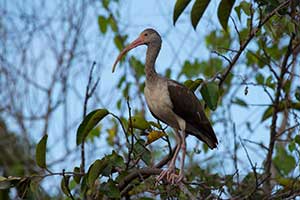 American White Ibis (Eudocimus albus)
American White Ibis (Eudocimus albus)
This is an immature bird, which is why the name seems strange. Look here for a photo of some adults, also in Florida.
I think this is just the standard American Crow, although there is a tiny possibility that it is the Fish Crow (Corvus ossifragus).
These were all over the place, everywhere we went.
I don't know why it's called a "Cay." It's inland from Boynton Beach and not an island at all.
This guy was a long way from me, so the photo is pretty magnified.
This bird, like the Merlin above, was a long way from me, so the photo is pretty magnified.
I wish I'd been able to get a shot of the male version of this bird away from the feeder.
Notice that this bird has a snail in its beak.
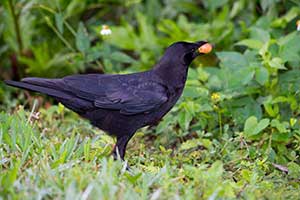 American Crow (Corvus brachyrhynchos)
American Crow (Corvus brachyrhynchos)
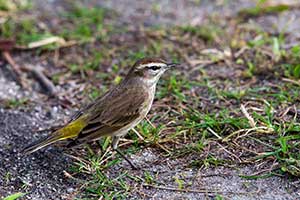 Palm Warbler (Setophaga palmarum)
Palm Warbler (Setophaga palmarum)
Florida: Green Cay Nature Center
This was a great place. It's a sort of artificial wetlands away from the coast and north of Miami, but it has a wooden walkway over the water for a bit more than a mile. Since it's artificial, the water level can be controlled by adding or removing water as necessary to keep it "correct" for the season. We saw lots of stuff, an best of all, it was free.
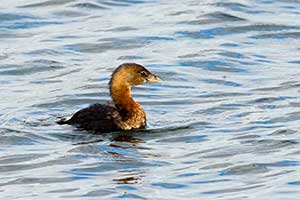 Pied-billed Grebe (Podilymbus podiceps)
Pied-billed Grebe (Podilymbus podiceps)

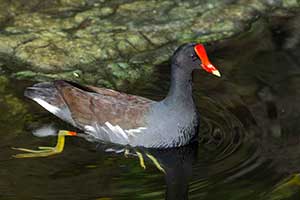 Common Gallinule (Gallinula galeata)
Common Gallinule (Gallinula galeata)
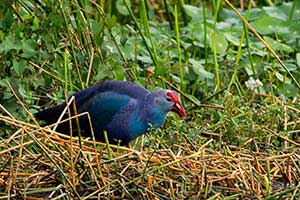 Purple Swamphen (Porphyrio porphyrio)
Purple Swamphen (Porphyrio porphyrio)
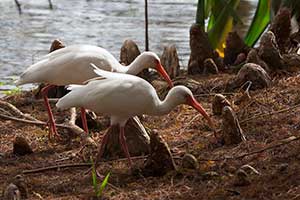 American White Ibis (Eudocimus albus)
American White Ibis (Eudocimus albus)
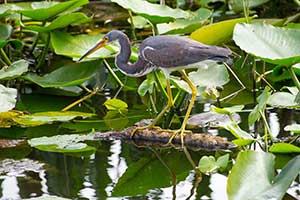 Tricolored Heron (Egretta tricolor)
Tricolored Heron (Egretta tricolor)
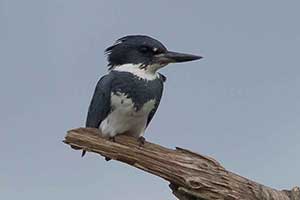 Belted Kingfisher (Megaceryle alcyon)
Belted Kingfisher (Megaceryle alcyon)

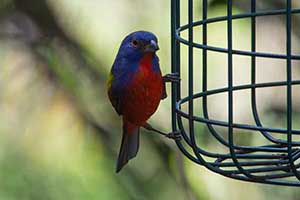 Painted Bunting (Passerina ciris); Female, left; Male, right
Painted Bunting (Passerina ciris); Female, left; Male, right
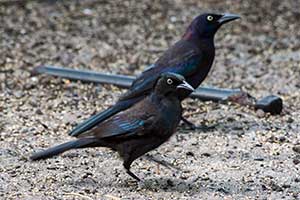 Common Grackle (Quiscalus quiscula)
Common Grackle (Quiscalus quiscula)
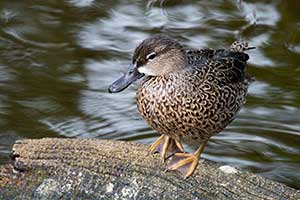 Blue-winged Teal (Anas discors)
Blue-winged Teal (Anas discors)
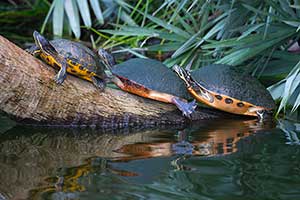
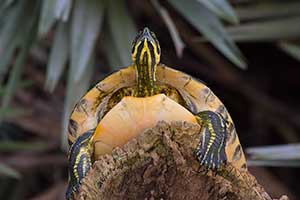 Florida Red-bellied Cooter (Pseudemys nelsoni)
Florida Red-bellied Cooter (Pseudemys nelsoni)
Florida: Everglades, Anhinga trail and south
 Car protection
Car protection
When we stopped at the Anhinga trail site in the Everglades, we were surprised to see that many of the cars in the parking lot were covered with blue tarps. Ellyn said that it was because the Black Vultures there have learned to rip the rubber from both the windows and windshield wipers of cars. I was amazed that everybody but us seemed to have known that, but in fact, there were loaner tarps and bungee cords at available for free.
We got a tarp but no bungee cord and attached it to ours by closing the hood on one end and closing the rear windows on the other two corners. It seemed to work fine; we lost no rubber while we were there, but we did see birds working on other cars.
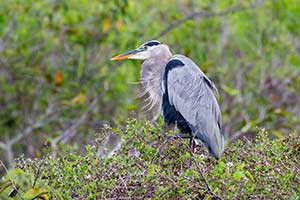 Great Blue Heron (Ardea herodias)
Great Blue Heron (Ardea herodias)
 Purple Gallinule (Porphyrio martinicus)
Purple Gallinule (Porphyrio martinicus)
It was really strange to see this guy climbing around in the bushes. Normally, they're down in the water. You can sure see his bright yellow legs in this photo, though.
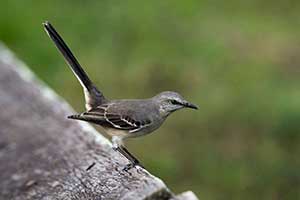 Northern Mockingbird (Mimus polyglottos)
Northern Mockingbird (Mimus polyglottos)
These guys were everywhere; this best photo happens to be taken in the Everglades, but I got plenty of similar ones all over Abaco.
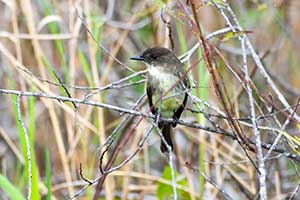 Eastern Phoebe (Sayornis phoebe)
Eastern Phoebe (Sayornis phoebe)
Before this trip, I had never seen this bird, but it was behaving exactly the same as the Phoebes we have at home, so it was pretty easy to look it up for a positive identification.
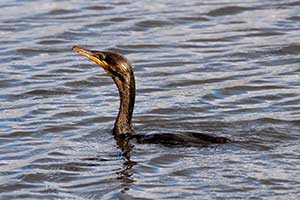 Double-crested Cormorant (Phalacrocorax auritus)
Double-crested Cormorant (Phalacrocorax auritus)
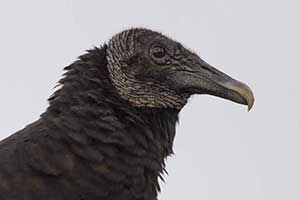 Black Vulture (Coragyps atratus)
Black Vulture (Coragyps atratus)
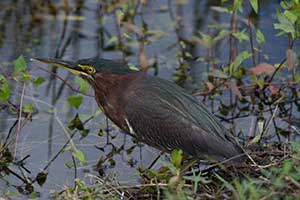 Green Heron (Butorides virescens)
Green Heron (Butorides virescens)
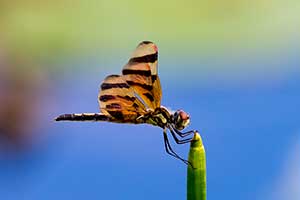 Halloween Pennant (Celithemis eponina)
Halloween Pennant (Celithemis eponina)
I was waiting for a bird and this dragonfly landed about 5 or 6 feet from me. I just twisted the camera around and took a "snapshot." With the lucky blurred background (blue water plus green and brown foliage) it turned out to be one of the best photos of the day.
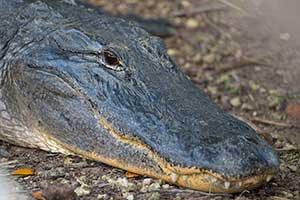 American Alligator (Alligator mississippiensis)
American Alligator (Alligator mississippiensis)
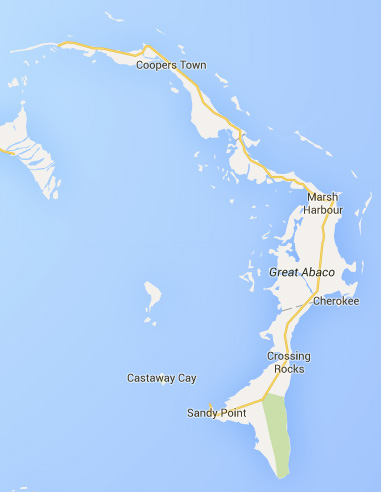
 We spent three days with Reggie as our guide. The first day we spent on the south end of Abaco, the second day on the north end of the island, and the third (which was just a half day on our last day on the island) we covered sites near Marsh Harbor, where the Lofty Fig was located. We saw everything from Coopers Town to Sandy Point.
We spent three days with Reggie as our guide. The first day we spent on the south end of Abaco, the second day on the north end of the island, and the third (which was just a half day on our last day on the island) we covered sites near Marsh Harbor, where the Lofty Fig was located. We saw everything from Coopers Town to Sandy Point.
On the left is a typical seashore view on Abaco.
Abaco is in the Bahamas, but is one of the northernmost of the islands, and it is actually a bit north of, and about 35 minutes, by air, from Miami.
The photos below were taken during those three days, but not necessarily in order.
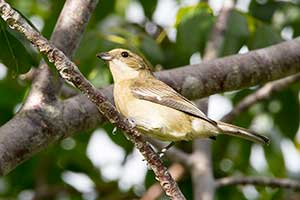
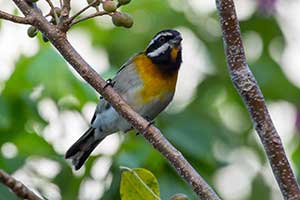
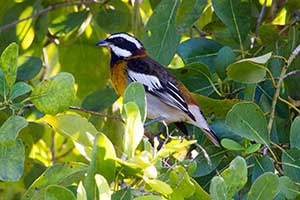 Western Spindalis (Spindalis zena)
Western Spindalis (Spindalis zena)
Female on the left; the other two are males.
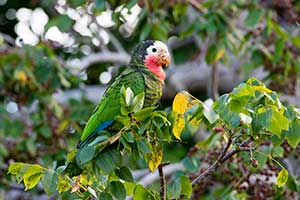 Cuban (or Bahama) Amazon (Amazona leucocephala bahamensis)
Cuban (or Bahama) Amazon (Amazona leucocephala bahamensis)
This bird is the signature bird for the island and we saw images of it everywhere, including a giant statue of it in the middle of a traffic roundabout between the airport and our lodge.
These parrots nest in limestone caves and the national park at the south end of the island is at least partially for their protection. We did travel through the national park, but as Reggie warned us, it is very difficult to see the parrots there. He did, however, know a private garden where we would be very likely to see them and see them we did.
I got a lot of nice photos, but the one on the left is the best.
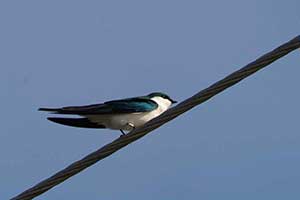 Bahama Swallow (Tachycineta cyaneoviridis)
Bahama Swallow (Tachycineta cyaneoviridis)
If you click on the thumbnail on the left for the larger version of the photo, you can see that this bird is banded on its right leg. Reggie said there is some gal doing her graduate work on this bird, so perhaps it was banded by her.
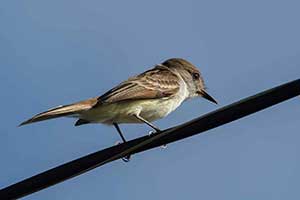 La Sagra's Flycatcher (Myiarchus sagrae)
La Sagra's Flycatcher (Myiarchus sagrae)
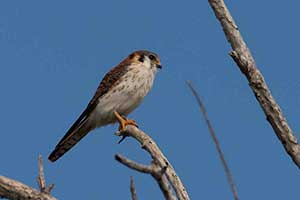 American Kestrel (Falco sparverius)
American Kestrel (Falco sparverius)
There were dozens of Kestrels on Abaco. We saw them over and over, usually standing on telephone poles or power poles. In fact, we saw three pairs of Kestrels mating, although the last two matings, viewed sitting around our lodge's pool with a beer, were probably the same pair.
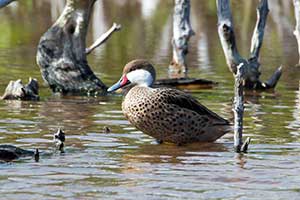 White-cheeked Pintail (Anas bahamensis)
White-cheeked Pintail (Anas bahamensis)
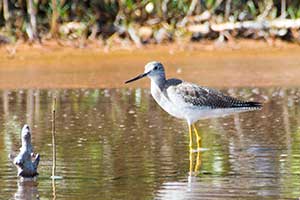 Greater Yellowlegs (Tringa melanoleuca)
Greater Yellowlegs (Tringa melanoleuca)

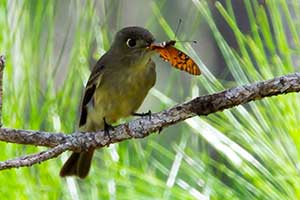
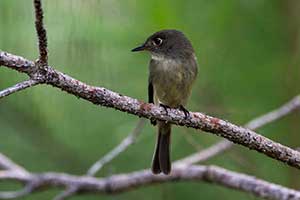 Cuban (or Crescent-eyed) Pewee (Contopus caribaeus)
Cuban (or Crescent-eyed) Pewee (Contopus caribaeus)
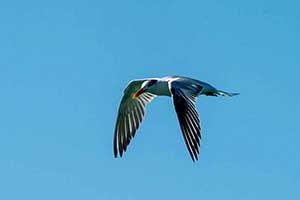 Sandwich Tern (Thalasseus sandvicensis)
Sandwich Tern (Thalasseus sandvicensis)
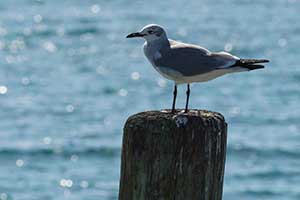 Laughing Gull (Leucophaeus atricilla)
Laughing Gull (Leucophaeus atricilla)
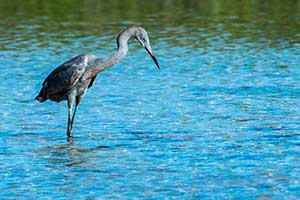 Reddish Egret (Egretta rufescens)
Reddish Egret (Egretta rufescens)
When we saw this bird the last time (a few years ago in Florida), it was like a maniac: running like crazy, shading the water, stabbing at fish, and then repeating, over and over. This guy was like a normal egret/heron, so we thought at first it was just a Little Blue Heron. We were also confused since Reggie said that the white morph of this bird is far more common in Abaco, so were were looking for a white Reddish Egret.
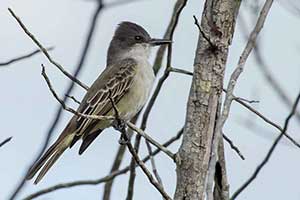 Loggerhead Kingbird (Tyrannus caudifasciatus)
Loggerhead Kingbird (Tyrannus caudifasciatus)
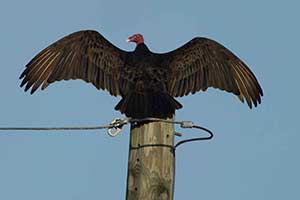
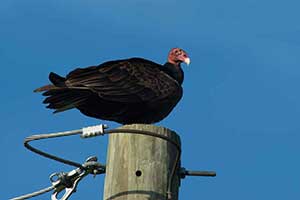 Turkey Vulture (Cathartes aura)
Turkey Vulture (Cathartes aura)
For some reason the only vulture on Abaco is the Turkey Vulture, while in both Florida and in the central and south American countries I've visited, the Black Vulture is more common.
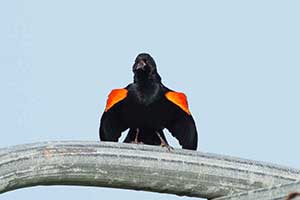 Red-winged Blackbird (Agelaius phoeniceus)
Red-winged Blackbird (Agelaius phoeniceus)
Although it was still winter at home, in the Bahamas this guy was already posturing for a mate. He's showing his red and yellow epaulets fully exposed and singing his heart out.
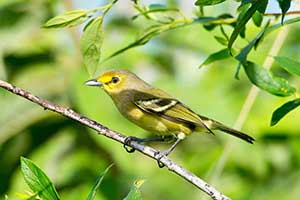 Thick-billed Vireo (Vireo crassirostris)
Thick-billed Vireo (Vireo crassirostris)
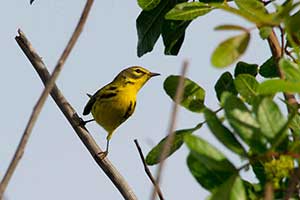 Prairie Warbler (Dendroica discolor)
Prairie Warbler (Dendroica discolor)
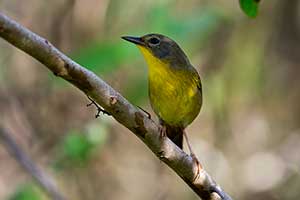
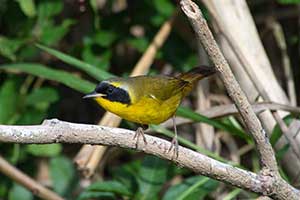 Bahama Yellowthroat (Geothlypis rostrata)
Bahama Yellowthroat (Geothlypis rostrata)
The female is on the left; the male on the right.
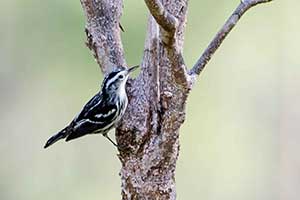 Black and White Warbler (Mniotilta varia)
Black and White Warbler (Mniotilta varia)
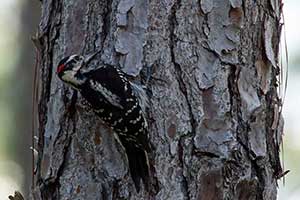 Hairy Woodpecker (Picoides villosus)
Hairy Woodpecker (Picoides villosus)
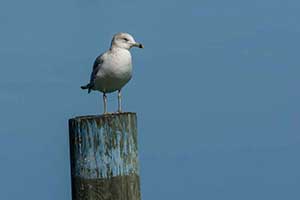 Ring-billed Gull (Larus delawarensis)
Ring-billed Gull (Larus delawarensis)
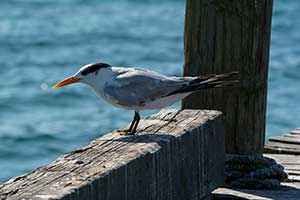 Royal Tern (Thalasseus maximus)
Royal Tern (Thalasseus maximus)
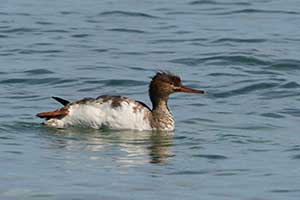 Red-breasted Merganser (Mergus serrator)
Red-breasted Merganser (Mergus serrator)
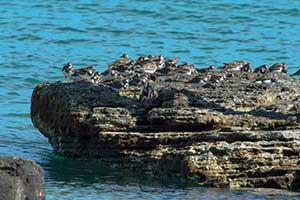 Ruddy Turnstones (Arenaria interpres)
Ruddy Turnstones (Arenaria interpres)
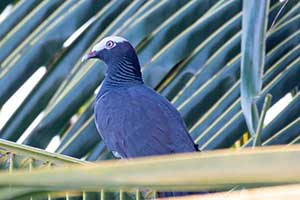 White-crowned Pigeon (Patagioenas leucocephala)
White-crowned Pigeon (Patagioenas leucocephala)
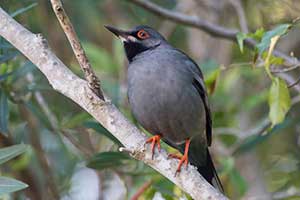
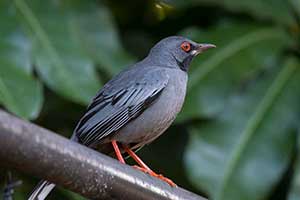 Red-legged Thrush (Turdus plumbeus)
Red-legged Thrush (Turdus plumbeus)
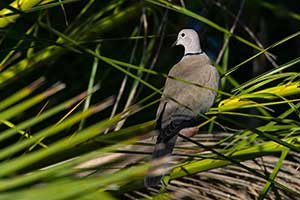 Eurasian Collared Dove (Streptopelia decaocto)
Eurasian Collared Dove (Streptopelia decaocto)
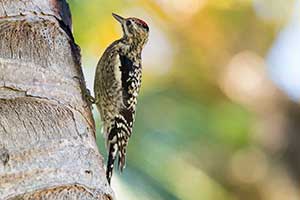 Yellow-bellied Sapsucker (Sphyrapicus varius)
Yellow-bellied Sapsucker (Sphyrapicus varius)
I took a lot of photos of this bird which was very uncooperative. When the bird finally flew and I was locking down the tripod, my wife Ellyn and the guide both said, "Wow!!!" It turns out that seconds after the Sapsucker flew, it was nailed in the air by a Kestrel. I missed all of it.
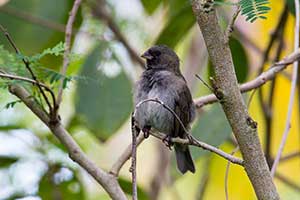 Black-faced Grassquit (Tiaris bicolor)
Black-faced Grassquit (Tiaris bicolor)
 Black-throated Green Warbler (Setophaga virens)
Black-throated Green Warbler (Setophaga virens)
 Atala or Coontie Hairstreak (Eumaeus atala)
Atala or Coontie Hairstreak (Eumaeus atala)

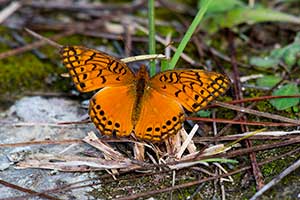 A couple of unknown lepidopterans
A couple of unknown lepidopterans
Abaco has a foundation of limestone that can slowly dissolve in rain water and there are a few of these blue holes on the island that can be hundreds of feet deep. They may or may not be connected to the sea, but most have a layer of fresh water sitting on top of the heavier salty water below.
There's usually almost nothing living in them, and in the correct light (which I did not have when we visited it) they have a beautiful blue color.
I could have gotten away with a smaller tripod, and the one I had is about 26 inches long, which is a pretty inconvenient size for a carry-on, especially on the smaller planes that connect Miami with the Bahamas.
The main problem with shooting at f/8 is that only the central focus point works well for auto focus, so sometimes I couldn't frame the shot exactly as I wanted to, but it was worth it for the extra range the 1.4x teleconverter gave me.
As backup I had a Nikon D800 body and one additional lens, the 28-120 f/4 VR, but I basically never used either of them. I always carry two bodies since if one fails, that's the end of your photography, and I've been on two different trips to the tropics where one of my camera bodies failed. The problem with the D800 is that it uses a different battery and collects data on a different pair of card types, so I had to bring two card readers, two battery chargers, and two kinds of spare batteries. But the D4 is so expensive that I sure didn't want to buy another one of those. With all the charger and card readers there were of course different cables for each so it was a pain to make sure I had all the correct cables.
All of the photos for the entire trip fit on one 64 GB memory card (the Sony XQD 64 GB). Every night I copied all the photos from the day onto a Macintosh Air laptop and didn't erase the card so I had a sort of backup situation. I had a few 32 GB Compact Flash cards that I could have used had the 64 GB card filled. All in all, I took about 1600 photos, all in Nikon RAW mode. I did all the post processing with Photoshop CS6. Every evening I tried to label all the photos of the day so I wouldn't forget.
I also brought the SB910 flash plus two sets of batteries and a recharger for those as well, and used it exactly zero times.
Want to send me email? tomrdavis@earthlink.net.